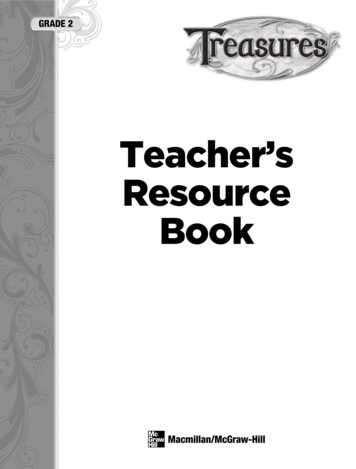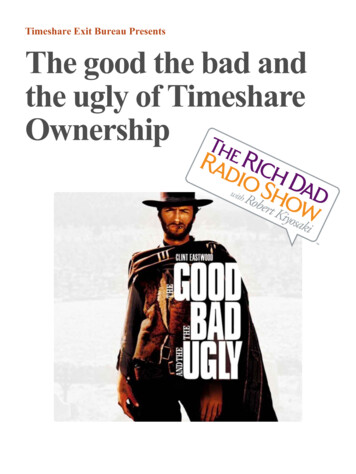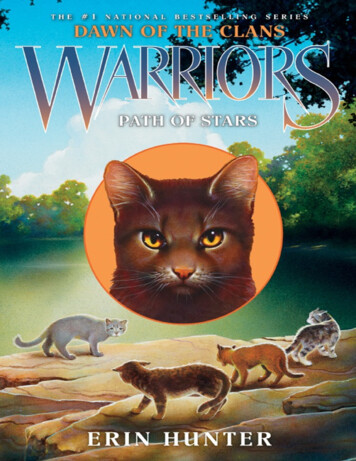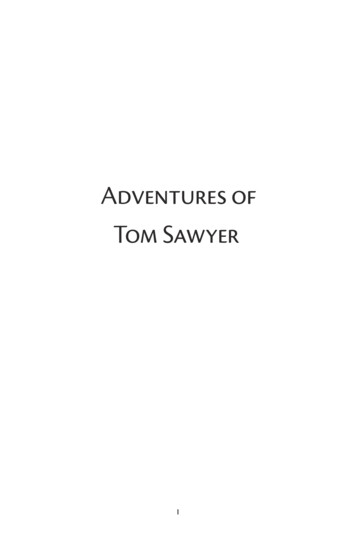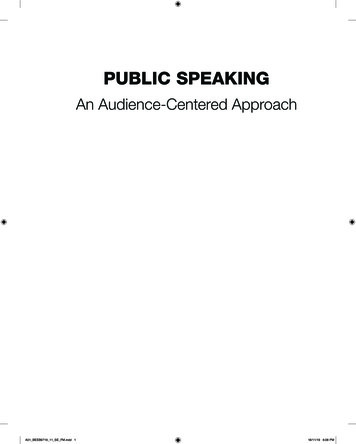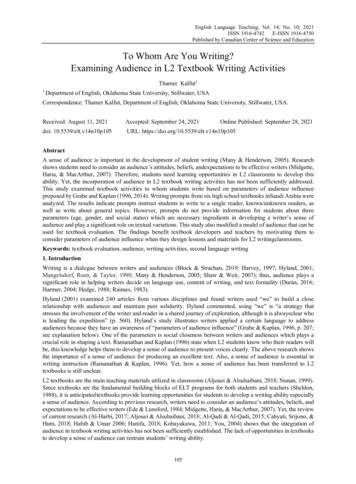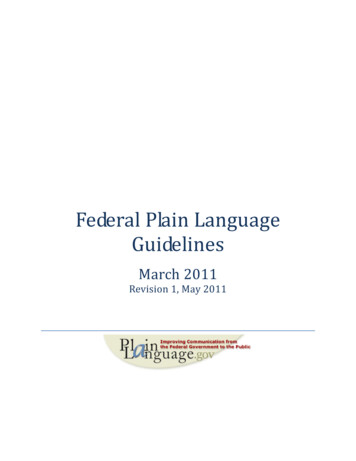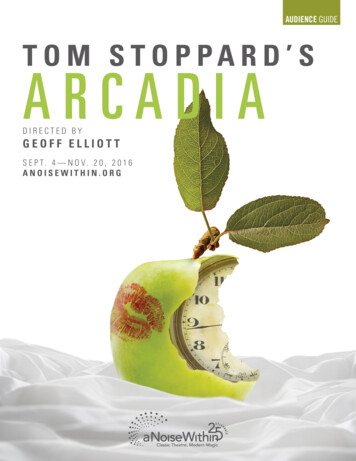
Transcription
AUDIENCE GUIDET O M S T O P PA R D ’ SARCADIADIRECTED BYGEOFF ELLIOTTS E P T. 4 — N O V. 2 0 , 2 0 1 6ANOISEWITHIN.ORG
TA B L E O FCONTENTSArcadia Character List . . . . . . . . . . . . . . . . . . . . . . . . . . . . . . . . . . . . . . . . . . . . . . 3Arcadia Characters: Notes From the Actors . . . . . . . . . . . . . . . . . . . . . . . . . . . . . 4Synopsis . . . . . . . . . . . . . . . . . . . . . . . . . . . . . . . . . . . . . . . . . . . . . . . . . . . . . . . . . 6Playwright Biography: Tom Stoppard . . . . . . . . . . . . . . . . . . . . . . . . . . . . . . . . . . 7Tom Stoppard Timeline. . . . . . . . . . . . . . . . . . . . . . . . . . . . . . . . . . . . . . . . . . . . . . 9Arcadia Themes . . . . . . . . . . . . . . . . . . . . . . . . . . . . . . . . . . . . . . . . . . . . . . . . . . 10Classicism and Romanticism in Sidley Park . . . . . . . . . . . . . . . . . . . . . . . . . . . . . 13Math and Science in Arcadia . . . . . . . . . . . . . . . . . . . . . . . . . . . . . . . . . . . . . . . . 14Order and Disorder:Classical and Romantic Physics in Arcadia. . . . . . . . . . . . . . . . . . . . . . . . . . . . . . 16Fun Fact: Thomasina Coverly and Ada Lovelace. . . . . . . . . . . . . . . . . . . . . . . . . 18Costume Renderings and Research . . . . . . . . . . . . . . . . . . . . . . . . . . . . . . . . . . 19Glossary. . . . . . . . . . . . . . . . . . . . . . . . . . . . . . . . . . . . . . . . . . . . . . . . . . . . . . . . . 21Resources and Further Reading. . . . . . . . . . . . . . . . . . . . . . . . . . . . . . . . . . . . . . 24A NOISE WITHIN’S EDUCATION PROGRAMS MADE POSSIBLE IN PART BY:The Ahmanson Foundation, AMC, The Capital Group Companies Charitable Foundation, The Michael J. Connell Foundation, The Dickand Sally Roberts Coyote Foundation, The Dwight Stuart Youth Fund, Edison International, The Green Foundation, The Michael &Irene Ross Endowment Fund of the Jewish Community Foundation of Los Angeles, Los Angeles County Board of Supervisors throughthe Los Angeles County Arts Commission, Metropolitan Associates, National Endowment for the Arts: Shakespeare in AmericanCommunities, The Kenneth T. & Eileen L. Norris Foundation, The Ralph M. Parsons Foundation, Pasadena Rotary Club, The AnnPeppers Foundation, The Rose Hills Foundation, The Shubert Foundation, The Steinmetz Foundation, The Sidney Stern Memorial Trust
Character List19TH CENTURYLady CroomCaptain BriceThomasina’s mother, acommanding spitfireLady Croom’s brotherThomasina CoverlyAugustus CoverlyA young, impetuous genius;aged 13, later 16Thomasina’s brotherSeptimus HodgeRichard NoakesAcademic, Tutor of Thomasina;aged 22, later 25A landscape architectEzra ChaterJellabyA poet and amateur biologistA butlerPRESENT DAYBernard NightingaleHannah JarvisA fame seeking fop;A charming charlatanAn authorChloe CoverlyThomasina’smodern dayequivalent;aged 183 A NOISE WITHIN 2016/17 Audience Guide ArcadiaValentineCoverlyChloe’solderbrotherGus CoverlyChloe’s youngerbrother;Augustus’smodern-dayequivalent, thispart is usuallydouble castwith the part ofAugustus
Arcadia Characters: Notes From the ActorsEzra Chaterplayed by Jeremy RabbWhat I find endearing about Chater is hisability to overlook the relentless assaultson his dignity for a taste of genuineaffirmation and fame. His utter lack oftalent, coupled with the brute force of hisego, is wonderfully fun to play in all its comic and tragicsplendor. The exaggerated quality of his bluster reflects,at its core, an actor’s similar need for self-preservation:“That critic doesn’t really hate my work: he’s upset aboutsomething in his life that has nothing to do with me Many great artists through the ages have been wronglyridiculed, so of course I’m misunderstood.” I also loveChater’s volatility, swinging from rage to affection to selfpity and then back again to rage all in an instant. Thisflipping of mood and opinion like a pancake is a traitactors share: “So-and-so didn’t like the show? Well, he’san idiot! Oh, but you say he loved MY performance andthinks I’M talented? Well, I’ve always admired his taste.”What makes the character so touching is that we can laughat his absurdity, while secretly recognizing the seed of hisinsecurity in ourselves.Hannah Jarvisplayed by Susan AngeloI first read Arcadia years ago when Iwas auditioning to understudy for bothHannah Jarvis and Lady Croom at theMark Taper Forum. I spent a good dealof time preparing for what was to mean impossibly difficult play to even read, much less act. Iwas offered the job, but due to a work conflict, ultimatelyhad to decline. Having only dipped a toe in, I hoped thatsomeday I would return to Arcadia. Years passed, and lastseason, I got to read the role of Hannah in ANW’s ResidentArtist Reading Series. No less in awe of Tom Stoppard’smind and brilliant craftsmanship, this time I put a foot in.So, when ANW selected Arcadia for its 25th anniversaryseason, and Geoff asked me to play Hannah Jarvis, I wasover the moon!! Finally, a chance to dive fully into thismasterpiece!What’s incredible about this play is that to get a handleon even a short exchange of dialogue, you are sentimmediately into the research mode: Classicism vs.Romanticism, Lady Caroline Lamb, Lord Byron, Historyof English Landscape, Capability Brown, Salvatore Rosa,Claude, Virgil, Chaos Theory, concepts of Entrophy, etc.With your head spinning, you grab hold of just enoughto be able to get through the scene, but are left with theopportunity to continue learning and deepening yourunderstanding of these subjects throughout rehearsals andperformances.4 A NOISE WITHIN 2016/17 Audience Guide ArcadiaIt is being thrust into the research mode that has broughtme into the world of Hannah Jarvis. I share her curiosity,her appetite for learning, her drive to discover and tomake sense of the injustices in the world. I also identifywith her comfort level that is more aligned with work thanplay; that trusts her brain more than her heart. Arcadia isa place where science is woven together with language,art and spirituality. Where the mystery of the universe ismore compelling than the absolutes we try to control, andthe chemistry between human beings is the most powerfulenergy of all.HA! Written like a “true Romantic”, which Hannah Jarvisemphatically is NOT! Or is she?Valentine Coverlyplayed by Tavis DoucetteValentine Coverly is a passionate anddedicated mathematician. He is the voiceof the sciences within the present dayera of the play, explaining complicatedtheories to the other characters and theaudience. In many ways, he embodies The Enlightenment,believing that scientific progress, knowledge, andrationalism are of paramount importance. Valentine isstudying population changes in grouse, a game bird similarto a pheasant, attempting to find the algorithm whichwould determine the population year to year. In otherwords, some very boring yet complicated stuff. He is inturmoil with his own mathematic endeavors, his lust forHannah, and the discovery of Thomasina’s potential genius.As a character, I am drawn to Valentine’s passion for work,and his undying thirst for knowledge. In his monologue toHannah, we get to see Valentine explore the joy of newdiscovery, and with it, being proven wrong: “It makes meso happy. To be at the beginning again, knowing almostnothing. It’s the best possible time to be alive, whenalmost everything you thought you knew is wrong.” Heis a dedicated man who, even in his own mathematicfailures, understands his mortality and the importance oflearning. Later in the play, while arguing with Bernard, weget to see Valentine express the importance of knowledgeover personalities: “The questions you’re asking don’tmatter, you see. It’s like arguing who got there first withthe calculus. The English say Newton, the Germans sayLeibnitz. But it doesn’t matter. Personalities. What mattersis the calculus. Scientific progress. Knowledge.” This is thethrust of Valentine’s purpose in Arcadia. He is the counterargument to Bernard’s robust, romantic idealism. He is therational voice amongst literary theorists. I look forward tolearning more about Valentine as I continue my journey intohis mind.
Arcadia Characters: Notes From the Actors continued.Lady Croomplayed by Abby CradenI love Lady Croom she is a strong,powerful, brilliant force of a woman in atime period where women were not valuedfor those qualities. I feel as an actor rolesare given to one to help access or in someways work something out in your own character and toget to embody Lady Croom is truly a gift. She is helpingme reconnect to my power and strength. At first I foundit a bit intimadating to play someone of such wealth andesteem but she is a person just like anyone else. And Iimagine she is a bit of a goddess which as an actress is funto play with in my imagination. I love getting to portrayboth a mother and wife and a lover -I don’t think there aremany women written as she is. As an artist to get to playwith Stoppards words and live in his brilliant mind is anexciting place to be.Bernard Nightingaleplayed by Freddy DouglasI remember seeing this play when itfirst came out at the National Theatre inLondon. It had the feeling of an event.The role I’m playing, Bernard Nightingaleis a wonderful character. His burningambition is to be thought of as a ground breaking historian.He has grown up, as all English people do, within a classsystem in which everyone knows their place. It is a silentunderstanding that who your parents are, where youwent to school, the accent you speak with has a powerfulinfluence on what is possible for you to achieve in life.Bernard Nightingale is trying to escape these restrictions.He is teaching in a 2nd grade University and knows thatto rise to the top of the academic world he needs a greatdiscovery.There is a reason Bernard has seized on the subject ofLord Byron. Byron was gifted, sexually impetuous, anddelighted in breaking the rules of the establishment. Byronalso had a club foot and was able to overcome his disabilityto become one of the most celebrated figures of his time.These are the qualities that Bernard reveres.Bernard has an internal ‘club foot’ of his own.A desperate need to prove himself better than all who havelooked down on him in his life.To meet him you would never guess, but as the playunfolds we see him unravel.5 A NOISE WITHIN 2016/17 Audience Guide ArcadiaGus and Augustus Coverlyplayed by Richy StorrsEveryone has a part of themselves thatis silent, a side that plays the role ofobserver or listener. Often it is when weare speechless or experiencing somethingthat is beyond words that we are mostfascinated. For Gus, this part of his mind has becomehis primary mode of existence and no one knows why. Iwonder if even Tom Stoppard knew! In the script, we’retold only that he “doesn’t speak. He never speaks. Perhapshe cannot speak.” What I love the most about Gus is thetotal sense of mystery that Stoppard gives him withoutsaying much at all. Gus speaks for himself in action aloneand, because we’re told so little about him, playing thepart has been a wonderfully imaginative experience. He is ablank slate, a silent reflection of the world around him. It’san added joy to also be able to play Augustus and work inboth time periods of the play.Thomasina Coverlyplayed by Erika SotoI love Thomasina’s intelligence anddetermination. Her mind works on somany different planes at once. Sheunderstands the world in pictures, images,and numbers. One of my favorite scenes iswhen she talks to Septimus about her pudding; imaginingthe jam swirling in her cup, she relates it to the picture ofa meteor in her astronomical atlas. This link leads to anamazing discovery she is never able to fully develop. So, avery simple, every day, common occurrence, in her mind, isimmediately connected to a bigger, cosmic understanding.Although I could never claim to be as smart as Thomasina(some even consider her a genius), I do connect to herpassion. She is an eager learner and is passionate abouther contributions to the subjects she is learning about.She trusts her instincts and makes amazing connectionsamong all the things around her—and still remains a younggirl, concerned with things like kissing and dancing! What Iwould most encourage the students to keep in mind is howbeautifully the play is written it is an example of the heatequation itself: One thing slowly going to another until anequilibrium is reached.
Synopsis“Et in Arcadia ego.” [“I am in Arcadia.”]—Sir Joshua ReynoldsArcadia is set in Sidley Park, Derbyshire, in an English country house. Itssurrounding gardens are about to be restyled in the “picturesque” Gothic style.ACT ONEThe play is set across two time periods: the early years ofthe 19th century and the present day. The action beginsin 1809, with Thomasina Coverly, the 13-year-old daughterof the house, and her 22-year-old tutor, Septimus Hodge.Ezra Chater, a poet and house guest at Sidley Park, accusesSeptimus of sleeping with his wife.Some two hundred years later, historian Hannah Jarvisand professor of literature Bernard Nightingale meet inthe same room of Sidley Park in which the previous scenestook place. Hannah is there to investigate a hermit whoonce lived on the estate. Bernard is trying to uncover amysterious chapter in the life of the poet Lord Byron. Thecharacters in the present day puzzle over artefacts left bythose in the 19th century.6 A NOISE WITHIN 2016/17 Audience Guide ArcadiaACT TWOIn the present day, Bernard rehearses a speech on histheory that Lord Byron murdered Ezra Chater. In 1809,early in the morning, Septimus returns from shootingrabbits to a proposition from Lady Croom, Thomasina’smother.The shifts in time begin to speed up and intersect. Toconfuse the matter, the present-day characters play dressups with costumes from the earlier period. The time periodof the past jumps forward a few years to 1812, Thomasinais now 16.As the characters in the present day continue their researchand history takes its course, the revelations come thick andfast. Written by Carl Nilsson-Polias. Reprinted with permission from SydneyTheatre Company. 16/february/synopsis-arcadia
Playwright Biography: Tom Stoppard By Dan RubinIt is a mistake to assume that playsare the end products of ideas(which would be limiting): the ideasare the end products of the plays.TOM STOPPARD was born Tomáš Straüssler in Zlin,Czechoslovakia, in 1937. In 1939 his family immigratedto Singapore, which Tom evacuated with his mother andbrother in 1942 before the World War II Japanese invasion.His father, who remained behind, was killed. Stoppard’smother became a manager of a shoe shop in Darjeeling,India, where Tom met the English language at MountHermon (a school run by American Methodists) and hismother met Kenneth Stoppard, a major in the British Army.In 1946, Kenneth brought his new family home with him toDerbyshire, England, and gave Tom the name he still usestoday.I write plays because dialogueis the most respectable way ofcontradicting myself.—Tom Stoppard in The New Yorker (1977)Arcadia depicts the 13-year-old Thomasina as a ravenousstudent, consuming all the information her tutor can puton her plate; Stoppard, on the other hand, found schooldistasteful. “The chief influence of my education on mewas negative. I left school thoroughly bored by the idea ofanything intellectual.” He left school at 17 and got a job asa reporter on the Western Daily Press in Bristol, where hisfamily had moved. He aspired to become a great journalist,but as a second-string critic he was slowly seduced by thetheater. In 1958, he saw Peter O’Toole as Hamlet—“[It]had a tremendous effect on me. It was everything itwas supposed to be. It was exciting and mysterious andeloquent”—and by 1960, Stoppard had decided to switchcareers. He went down to writing just two columns a weekto cover expenses and began his first play, A Walk on theWater (later revised and called Enter a Free Man). With it,he introduced himself to Kenneth Ewing, who has been hisagent ever since.It was Ewing who had the idea that “there was a play tobe written about Rosencrantz and Guildenstern after theygot to England.” In 1964, on a five-month Ford Foundationgrant that paid for him and 19 other young Europeanplaywrights to live and write as part of a cultural exchangein a Berlin mansion, Stoppard wrote Rosencrantz andGuildenstern Meet King Lear, the one-act first draft of7 A NOISE WITHIN 2016/17 Audience Guide ArcadiaTom Stoppard.Rosencrantz and Guildenstern Are Dead. After the RoyalShakespeare Company and the Royal Court rejected it,Ewing reluctantly allowed university students to performthe play in the Edinburgh Festival Fringe on “a stage thesize of a ping pong table.” Observer theater critic RonaldBryden hailed it as “the most brilliant debut by a youngplaywright since John Arden’s.”Kenneth Tynan, literary manager of London’s NationalTheatre, requested the script. After conferring with hisartistic director, Sir Laurence Olivier, Tynan told Stoppardthey wanted it. The National Theatre produced Rosencrantzand Guildenstern Are Dead at the Old Vic in April 1967,making the 27-year-old Stoppard the youngest playwrightthe theater had ever produced. In October, Rosencrantzand Guildenstern was the first National Theatre productionto transfer to Broadway.On opening night in New York, Stoppard awaited thereviews at a pub near the theater; as they started to comein, and it was clear they were positive, a bartender winkedat the young playwright and said, “Ah, you’re in, kid!”The play won the Tony Award for Best Play. Back home,the arrival of the “boy genius” was likened to the SecondComing of Harold Pinter.THE ORIGINS OF ARCADIAStoppard has said about his 1946 arrival to the UnitedKingdom, “As soon as we all landed up in England, Iknew I had found a home. I embraced the languageand the landscape.” (His family lived near the elegantgardens of Chatsworth, which showcased four periodsof garden design.) His love of the English language andlandscape are apparent in his masterwork, Arcadia. In1989, after a 20-year career writing hits and misses intheater, television, and radio, Stoppard read James Gleick’sChaos, and despite the lukewarm reception of Hapgood(Stoppard’s 1988 experiment with quantum mechanics), the
Playwright Biography: Tom Stoppard By Dan Rubinplaywright “gambled that those who disliked physics mightnevertheless be seduced by chaos,” writes Ira Nadel in TomStoppard: A Life.Stoppard has explained that he always begins his playswith an intellectual idea, and chaos theory—specifically thenotion of geometric convergence and periodic doubling—was to be Arcadia’s kernel (as was the notion of entropy,or the dissipation of energy). But he found it too abstracta concept on its own. In 1990, he visited the home of hisfriend Paul Johnson (a British historian, political writer, andformer editor of the New Statesman) to look through hislibrary for inspiration. Stoppard explained in 1994:He has a lot of books. And looking at themI said: “I’m sure there’s a play about thedifference between Romantic and Classicalattitudes and eras.” He had some books onByron on that shelf. I even think I borrowed oneor two. I acquire knowledge little by little.Back home, Stoppard already had books on landscapearchitecture, mathematics, and hermits in his owncollection.The character of Lord Byron first interested Stoppardwhen he read a Peter Quennell book about the poet in the1980s; as he started to envision Arcadia, Lord Byron lenthimself as an offstage presence. Providing his scientificexpertise to the project, Oxford professor of mathematicalbiology Robert May drew Stoppard’s attention to LordByron’s daughter, the mathematical genius Ada. Theplaywright has denied basing Arcadia’s Thomasina onAda Byron, but the parallels are notable even if—perhapsespecially if—they are coincidental.Originally, Stoppard thought to call his play by the full Latinphrase “Et in Arcadia ego,” which appears in two famousseventeenth century Poussin paintings, both of whichdepict three Arcadian shepherds and a woman gatheredaround a sarcophagus with this inscription chiseled intoit. The literal translation is “Even in Arcadia here I [Death]am,” suggesting that death exists even in paradise. Nadelwrites, “Stoppard wanted the presence of death in the title,but brevity and box-office sense prevailed: ‘death is now inthe title only by imaginative extension,’ he confessed.”In April 1993, Stoppard opened Arcadia— which hecalled “a thriller and a romantic tragedy with jokes”—atthe National Theatre, which had committed to the playbefore a word had been written. Trevor Nunn directed andProfessor May tutored Samuel West (who played Valentine),Emma Fielding (who played Thomasina), and the rest ofthe cast in chaos theory and mathematical modeling. May’sgraduate student Alun Lloyd even developed the “Coverly8 A NOISE WITHIN 2016/17 Audience Guide ArcadiaWestall, Richard. Lord Byron. 1813. National Portrait Gallery, London.Set” for the show: a simple formula that creates thecomplex leaf shape Thomasina discovers in the play.Arcadia was a popular and critical success. The productionwon both the Evening Standard and Olivier awards for bestplay of the year; it ran for two seasons (431 performances).The script, available for purchase at the National Theatre’sbookshop, outsold all other plays in print, includingShakespeare: 6,000 copies were sold in the first threeweeks of the run. “Arcadia marked a watershed,” writesNadel. “It reaffirmed Stoppard’s importance in the theater,not just in Britain but beyond.” This article by Dan Rubin first appeared in American ConservatoryTheater’s performance guide series, Words on Plays, in 2013. For moreinformation about Words on Plays, visit www.act-sf.org/wordsonplays.
Tom Stoppard Timeline1937—— T omas Straussler is born in Zlin, Czechoslovakiaon July 3.1939—— W hen Nazis invade Czechoslovakia, the Strausslerfamily escapes to Singapore.1942—— B efore the Japanese invasion of Singapore,Tomas, his mother, and brother are evacuated toIndia. His father is killed in the invasion.1945—— H is mother marries Kenneth Stoppard, a BritishArmy officer. The family moves to England,settling in Bristol, where Kenneth Stoppardadopts his two stepsons.1954—— S toppard chooses to skip university and becomesa cub reporter for the Western Daily Press,Bristol.1958—— S toppard joins the Bristol Evening World as newsreporter, feature writer, and theater and filmcritic.1960–1961—— S toppard quits the newspaper to write hisfirst play, Walk on the Water, followed by TheGamblers and The Stand-Ins. He remains afreelance journalist for three years.1962–1963—— S toppard becomes the theater critic for theScene, London, using the pseudonym, WilliamBoot.1965—— Stoppard marries Jose Ingle, a nurse.1977—— T he New York Times publishes “Dirty Linen inPrague” concerning repression in Czechoslovakia.Stoppard travels to Moscow and Leningrad witha group from Amnesty International.1978—— S toppard is honored as a CBE (Commander ofthe Order of the British Empire).1980—— T he film of Stoppard’s screenplay of The HumanFactor is released.1984—— T he US premiere of The Real Thing, opens at thePlymouth Theatre, NYC, winning the Tony Awardfor Best Play.1992—— S toppard‘s marriage to Miriam Stoppard endsin divorce. He openly courts actress FelicityKendal, who appeared in several of his previousproductions. The first attempt at filming hisscreenplay of Shakespeare in Love falls through.1993—— T he National Theatre production of Arcadiaopens.1995—— T he US premiere of Arcadia opens at the VivianBeaumont Theatre at Lincoln Center, NYC.1997—— S toppard‘s adaptation of Chekhov’s The Seagullis performed at the Old Vic, London. Stoppard isknighted on December 12 and becomes Sir TomStoppard.1998—— S toppard writes a screen adaptation(unproduced) of his 1993 stage play, Arcadia. Thefilm Shakespeare in Love opens in December.1966—— R osencrantz and Guildenstern Are Dead, revisionof an earlier one-act play, is performed onthe Edinburgh Fringe Festival. His novel LordMalquist and Mr Moon is published.1999—— S toppard wins an Academy Award for hisscreenplay of Shakespeare in Love.1967—— T he US premiere of Rosencrantz andGuildenstern Are Dead opens at the AlvinTheatre, transferring to the Eugene O’NeillTheatre in 1968. It wins the Tony Award for BestPlay of the Year.2005—— S toppard creates a half-hour stage version ofWilliam Shakespeare’s The Merchant of Venice foryoung actors.1968—— E nter a Free Man is produced at the St. Martin’sTheatre, London, The Real Inspector Hound isproduced at the Criterion Theatre, London.1970—— T he first US production of The Real InspectorHound opens at Brown University, Providence RI.Stoppard writes a screenplay loosely based onBrecht’s The Life of Galileo.1972—— T he National Theatre production of Jumpersopens at the Old Vic. Stoppard divorces JoseIngle and marries Miriam Moore-Robinson.9 A NOISE WITHIN 2016/17 Audience Guide Arcadia2001—— T he New York Shakespeare Festival production ofThe Seagull opens, directed by Mike Nichols.2007—— T he American premiere of Heroes opens atthe Geffen Theatre, Los Angeles. The BourneUltimatum, the film of TS’s screenplay (co-writtenwith Tony Gilroy) is released.2012—— S toppard adapts Ford Madox Ford’s novelParade’s End for an HBO miniseries, and LeoTolstoy’s Anna Karenina as a screenplay.2016—— A revival of Stoppard’s play Travesties is plannedfor the fall at Menier Chocolate Factory theatrein London. His film adaptation of the novel TulipFever by Deborah Moggach is released in April.
Arcadia: Themes & IdeasFIRST THERE WAS NEWTON. Prior to the developmentof chaos theory, Isaac Newton organized the forcesof the natural world into a set of rules and laws. Histheories deemed the entire natural world and universe aspredictable using a mathematical linear equation. Newtonand his scientific followers believed anything that wasmore complex and not entirely solvable through thoselinear equations just needed a more complex equation, butwas ultimately able to be predicted. Newton’s laws weresaying that the future was pre-destined and fixed with noroom for random events or chaos. Today, we know this isdefinitely not the case. In the 1800s, Septimus addressesthe limitations of Newton’s theories when he says “Ifeverything from the furthest planet to the smallest atom ofour brain acts according to Newton’s law of motion, whatbecomes of free will?” (Arcadia, 9). Thomasina also starts tothink about the validity of Newton’s laws and asks whetherGod, who created the Earth, was a Newtonian. Knowingfull-well that this couldn’t have been the case, she says “Ifyou could stop every atom in its position and direction,and if your mind could comprehend all the actions thussuspended, then if you were really, really good at algebrayou could write the formula for all the future” (Arcadia, 9).THEN THERE WAS CHAOS. What chaos theory did wasturn this paradigm on its head. A simple computationaloversight by mathematician and meteorologist EdwardLorenz showed that seemingly insignificant changes in theinitial conditions of a system (such as the weather) canhave huge ramifications. It’s a phenomenon now widelyreferred to as ‘the butterfly effect,’ the idea that a butterflydisturbing the air today in Sydney might magnify a stormsystem next month in Madrid. Soon, chaotic behaviorbegan to be recognized throughout the natural world:in the movements of planets, the fluctuations in insectpopulations, shifts in ocean temperature, the rhythmsof a beating heart, the turbulence of a river’s flow, andin the basic geometry of nature itself. The fuzziness (orcomplexity) of systems was far from peripheral. Rather,it was the very distortions of things like clouds andmountains—the ways they failed to comply with simplegeometrical shapes (such as circles and cones)—whichwere crucial to our understanding of the way the universeworked. Thomasina also notices this and says, “Eachweek I plot your equations dot for dot, xs against ys inall manner of algebraical relations, and every week theydraw themselves as commonplace geometry, as if theworld of forms were nothing but arcs and angles. God’struth, Septimus, if there is an equation for a curve like abell, there must be an equation for one like a bluebell andif a bluebell, why not a rose?” (Arcadia, 51). The algebraThomasina talks of for making bluebells and roses (naturalshapes that are not lines or circles) is called Fermat’sLast Theorem and uses iterated algorithms or fractals tocreate the pattern of the shapes. Fermat wrote in the1 0 A NOISE WITHIN 2016/17 Audience Guide ArcadiaIssac Newton.margin of a book he was reading, Arithmetica, that he haddiscovered the proof for this idea but the margin was toosmall for him to write it. This theorem remained unsolveduntil 1993 when it was proven by a Princeton Universitystudent (the same year Arcadia was written). Valentineis also using iterated algorithms to create an equationabout population changes in grouse at Sidley Park. Chaostheory became a means by which apparently random andchaotic behaviors could be reconciled with notions of orderand organization. Within disorder, ‘islands of structure’existed—think of something like the Great Red Spot that isa constant feature of Jupiter’s ever-swirling storms. It was“one coin with two sides
someday I would return to Arcadia. Years passed, and last season, I got to read the role of Hannah in ANW's Resident Artist Reading Series . No less in awe of Tom Stoppard's mind and brilliant craftsmanship, this time I put a foot in . So, when ANW selected Arcadia for its 25th anniversary season, and Geoff asked me to play Hannah Jarvis, I was

